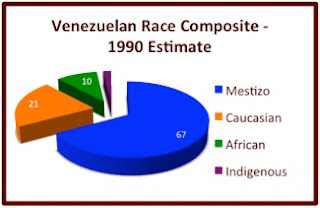The current Venezuelan concept of race was first
formed during Spanish colonization. At that time, one’s racial status was
determined through ethnic, religious, and economic considerations - and it
mattered. A person’s socioeconomic class and economic possibilities were
strongly tied to race.
Over time, such overt recognition and response to race was overtaken by a more subversive, possibly more pernicious, means of racial relation. In efforts to homogenize and “improve” colonized populations, the Spanish followed the doctrine of mestizaje, or racial mixing. Under this melting pot strategy, designed to yield one consolidated market under the control of the Spanish crown, first native Americans and eventually African arrivals were assimilated as peasants.
Through centuries of extensive ethnic mixing, eventually it became difficult distinguish between defined races in Venezuela. After 1926, there has been no national census classified according to ethnicity, and Venezuelans proudly proclaim mantra, “We’re all mestizos.” However, evident racial divisions do persist in the nation. In 1990, the racial composition of the Venezuelan population was estimated at 68 percent mestizo, 21 percent unmixed Caucasian, 10 percent african, and 1 percent indigenous[1].
Over time, such overt recognition and response to race was overtaken by a more subversive, possibly more pernicious, means of racial relation. In efforts to homogenize and “improve” colonized populations, the Spanish followed the doctrine of mestizaje, or racial mixing. Under this melting pot strategy, designed to yield one consolidated market under the control of the Spanish crown, first native Americans and eventually African arrivals were assimilated as peasants.
Through centuries of extensive ethnic mixing, eventually it became difficult distinguish between defined races in Venezuela. After 1926, there has been no national census classified according to ethnicity, and Venezuelans proudly proclaim mantra, “We’re all mestizos.” However, evident racial divisions do persist in the nation. In 1990, the racial composition of the Venezuelan population was estimated at 68 percent mestizo, 21 percent unmixed Caucasian, 10 percent african, and 1 percent indigenous[1].
Further, it is widely recognized that skin color differences still remain highly correlated with socioeconomic status in Venezuela. This situation came to a head in 1989. In response to neoliberal policies that had doubled transportation costs in Caracas, the poor and racialized masses living in the barrios of Caracas took over the city. Though President Perez instituted marshal law and deployed the army to the barrios where they slaughtered many poor civilians, the wealthy of Caracas still look back with fear on “the day the blacks came down from the hills.” This eventually catalyzed bourgeois segregation, and propelled the development of gated and fortified communities kept “safe” from poor slum areas by residential checkpoints[2].
Such racial fear and distrust has persisted since the Caracazo and
worsened racial inequality in Caracas. The stratification of races is evident
at demonstrations in the city in which darker skinned (and presumably lower
class) Venezuelans are seen supporting the Chavez government and lighter
skinned (presumably middle and upper class) groups demonstrate in opposition.
 |
| Chavez's Supporters |
 |
| Chavez's Opposition |
Yet,
the racial inequality in socioeconomic conditions continues to be largely
ignored, often cloaked in the garb of antiracism. It is ostensibly due to an
egalitarian racial ethic that the Venezuelan national census is not conducted
according to race. However, in 2004, Jesus Garcia, a founder of the
Afro-Venezuelan Network and expert on the Afro-Venezuelan community noted that
Network was pressing to have the government begin reclassifying the census by
race, so that economic conditions could be tracked according to race. In his
opinion denying the racism in the system just made it worse (VenezuelAnalysis).
Thus, race is held in ongoing tension in Caracas. It is an issue
that, even if subverted by popular claims of unity, is definitively not
settled; it is a need to be addressed. Tuning of that tension associated with
race will be part of the process of developing the coming urbanism of Caracas.
The city will be instrumental in forming the new race relationships.
In comparison, Seattle (another S&M city) seems to exhibit
similar covert racial tension. The city maintains a pervasive image of unified
cultural tolerance, yet geographic reality of segregation in the city tells a
different story. Race is an issue held in tension in Seattle, though it is not
much discussed. Just yesterday, our local paper noted that the feds have once
again declared race legitimate grounds for school assignment decisions (SeattleTimes).
You can be sure there will be an elitist backlash against this ruling. The
response to tension around race going forward will be part of the Seattle’s
instrumental role in creating the coming urbanism in the Puget Sound Region.
Finally, I would note the contrast evident in the race-related situations
in Caracas and Dubai, both S&M cities. In Dubai, racism is certainly
rampant, but the unchecked state powers escalate the racial disparities of
Caracas to a level near the autocratic speciation depicted in The Time
Machine. While the government in Caracas is fragmented by municipalities
and absent or ineffectual in the barrios, the police and surveillance power in
Dubai is almost totalitarian. In Dubai, while race is certainly a salient and
pressing issue, it is not one held in tension – it seems to be a broken element,
one force having overwhelmed the other entirely. For that reason, unless social
forces draw race back into active tension, the city may not be instrumental in
creating a new urbanism responsive to issues of race.

No comments:
Post a Comment